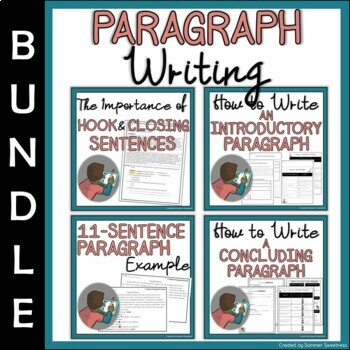Paragraph Writing BUNDLE
- Zip
Products in this Bundle (4)
Description
This Paragraph Writing BUNDLE contains four resources to improve students' paragraph writing.
RESOURCE ONE: The Importance of Hook and Closing Sentences
Writing the first and last sentence of a paragraph or essay can be daunting...but not anymore! Show your students the importance of writing a good hook/attention grabbing sentence and a closing sentence.
PURPOSE: To teach students the value of including a hook/attention grabber sentence and a closing sentence when you write.
INCLUDES:
1. Color copy of writing sheet
2. Black & white copy of writing sheet
3. Answer Key
COMMON CORE STANDARDS
With some guidance and support from peers and adults, develop and strengthen writing as needed by planning, revising, editing, rewriting, or trying a new approach, focusing on how well purpose and audience have been addressed.
- W 3.5, W 4.5, W.5.5, W.6.5, W.7.5, W.8.5, W.9-10.5, W.11-12.5
RESOURCE TWO: 11-Sentence Paragraph Example
Are your students still struggling to write a complete paragraph? Use this 11-Sentence Paragraph Example to dissect an 11-sentence paragraph. This resource will SHOW students visually what should be included in a paragraph. Students will be underlining, drawing, and coloring as a way to identify what belongs in an 11- sentence paragraph.
INCLUDES:
1. A color copy of the writing activity
2. A black-and-white copy of the writing activity
3. Answer key
COMMON CORE STANDARDS
- With guidance and support from adults, produce writing in which the development and organization are appropriate to task and purpose.
W3.4, W4.4, W5.4, W6.4, W7.4, W8.4
- Write routinely over extended time frames (time for research, reflection, and revision) and shorter time frames (a single sitting or a day or two) for a range of discipline-specific tasks, purposes, and audiences.
- W.3.10, W.4.10, W.5.10, W6.10, W7.10, W8.10, W.9-10.10, W.11-12.10
RESOURCE THREE: How to Write an Introductory Paragraph
The hardest part of writing is getting started! Do you have students that would agree with that statement? How should you instruct students to write an introductory paragraph? Look no further. Follow this easy guide to teach students to write an introductory paragraph effortlessly.
This writing resources is a comprehensive guides that teaches students how to write an introductory paragraph. Students will learn how to write hook sentences and a thesis statement. Students will also be able to explain the differences between hook and thesis sentences. Students will be able to apply the knowledge gained from this resource to more effectively write introductory paragraphs.
INCLUDES:
- Hook Sentences guided notes
- Hook Your Reader information sheet – types and examples of hook statements
- Thesis Statement guided notes
- Thesis Statement Examples sheet
- Hook Sentence vs. Thesis Statement – blank
- Hook Sentence vs. Thesis Statement – guided notes
- Hook Sentence vs. Thesis Statement – filled in completely
- An Introductory Paragraph Example sheet
- Label an Introductory Paragraph sheet
- Write an Introductory Paragraph sheet
- Answer keys
COMMON CORE STANDARDS
- W3.2a, 4.2a, 5.2a, 6.2a, 7.2a, 8.2a, W.9-10.2a, W.11-12.2a
- W3.3a, 4.3a, 5.3a, 6.3a, 7.3a, 8.3a, W.9-10.3a, W.11-12.3a
RESOURCE FOUR: How to Write a Concluding Paragraph
Do your students struggle with writing a one-sentence conclusion? Unfortunately, the one-sentence conclusion won't suffice. Your students need to be able to write a complete concluding paragraph. Good news...this resource will guide your students through the entire process of writing a concluding paragraph!
This writing resources is a comprehensive guides that teaches students how to write a concluding paragraph. Students will learn how to write a concluding statement and closing sentence. Students will also be able to explain the differences between a concluding and closing sentences. Students will be able to apply the knowledge gained from this resources to more effectively writing concluding paragraphs.
INCLUDES:
1. Concluding Statement guided notes
2. Concluding Statement Examples sheet
3. Closing Sentences guided notes
4. Ways to Close Your Writing information sheet – types and examples of closing
sentences
5. Concluding Statement vs. Closing Sentence – blank
6. Concluding Statement vs. Closing Sentence – guided notes
7. Concluding Statement vs. Closing Sentence – filled in completely
8. A Concluding Paragraph Example
9. Label a Concluding Paragraph
10. Write a Concluding Paragraph
11. Answer Keys
COMMON CORE STANDARDS
- W3.2d, 4.2e, 5.2e, 6.2g, 7.2g, 8.2g, W.9-10.2g, W.11-12.2g
- W3.3d, 4.3e, 5.3e, 6.3e, 7.3e, 8.3e, W.9-10.3e, W.11-12.3e
Remember that leaving feedback earns you points toward FREE TpT purchases.
Also, click here to follow me and be notified when new products are uploaded.
All the best in teaching,
Summer Sweetness





